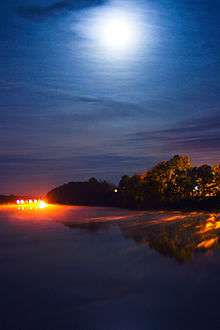Sebasticook River
| Sebasticook River | |
|---|---|
 | |
| Country | United States |
| Basin | |
| Main source |
Maine 750 feet (230 m) |
| River mouth |
Kennebec River 32 feet (10 m) 44°32′19″N 69°37′54″W / 44.5386°N 69.6317°WCoordinates: 44°32′19″N 69°37′54″W / 44.5386°N 69.6317°W |
| Physical characteristics | |
| Length | 76 miles (122 km) |
| Features | |
| Tributaries | |
The Sebasticook River is a 76-mile-long (122 km)[1] river in the central part of Maine, in the United States. From its source (45°03′17″N 69°13′36″W / 45.05480°N 69.22655°W) in Dexter, the upper "Main Stream" section flows generally west and south 30 miles (48 km) to Great Moose Lake. From the outlet of the lake in Hartland, the Sebasticook flows 41 miles (66 km) south to the Kennebec River in Winslow.
According to the Sebasticook Regional Land Trust:
The Sebasticook River is the largest tributary (985 square miles) to the Kennebec and thus plays an important role in the restoration of both the anadromous and resident aquatic fisheries of the Kennebec basin and the Gulf of Maine ecosystem. Due to its relatively close proximity to the lower Kennebec, large drainage area, and low gradient, this watershed historically contributed a major percentage of available spawning and nursery habitat for anadromous runs of alewife, blueback herring, American shad, rainbow smelt, and striped bass associated with the Kennebec River watershed and Gulf of Maine ecosystems. To a lesser extent, the river provided habitat for Atlantic salmon.
Great Moose Lake
| Great Moose Lake | |
|---|---|
| Location | Somerset County, Maine |
| Coordinates | 44°55′N 69°31′W / 44.917°N 69.517°W[2] |
| Basin countries | United States |
| Max. length | 5 mi (8.0 km)[3] |
| Max. width | 1.5 mi (2.4 km)[3] |
| Surface area | 3,856 acres (1,560 ha)[4] |
| Max. depth | 50 feet (15 m)[5] |
| Water volume | 52,697 acre·ft (65,001,000 m3)[4] |
| Surface elevation | 243 ft (74 m)[2] |
Great Moose Lake (formerly known as Moose Pond) is the second-largest lake in the Sebasticook River watershed, and the largest on the main stem of the river.[3] The lake is a good habitat for smallmouth bass, white perch, chain pickerel, and rainbow smelt.[5] Lake tributaries Black Stream, Wichee Brook, Brown Brook, Higgins Brook, Goodwin Brook, and Little Ferguson Brook provide smelt spawning habitat.[3] Despite marginal summer conditions of warm surface waters and low dissolved oxygen concentrations below the 7-metre (23 ft) thermocline, the Maine Department of Inland Fisheries and Wildlife has attempted to stock the lake with salmon.[5]
See also
References
- ↑ U.S. Geological Survey. National Hydrography Dataset high-resolution flowline data. The National Map, accessed June 30, 2011
- 1 2 U.S. Geological Survey Geographic Names Information System: Great Moose Lake
- 1 2 3 4 The Maine Atlas and Gazeteer (Thirteenth ed.). Freeport, Maine: DeLorme Mapping Company. 1988. pp. 21&31. ISBN 0-89933-035-5.
- 1 2 Maine Depts. of Environmental Protection and Inland Fisheries & Wildlife (2005-08-04). "Maine Lakes: Morphometry and Geographic Information". Senator George J. Mitchell Center for Environmental and Watershed Research, The University of Maine. Retrieved 31 July 2008.
- 1 2 3 "Moose Pond" (PDF). Maine Department of Inland Fisheries and Wildlife. State of Maine. Retrieved 11 May 2016.
- "Sebasticook River". Geographic Names Information System. United States Geological Survey. 30 September 1980. Retrieved 2013-05-20.
- "Main Stream Sebasticook River". Geographic Names Information System. United States Geological Survey. 30 September 1980. Retrieved 2013-05-20.